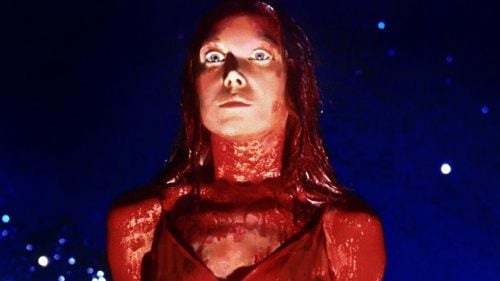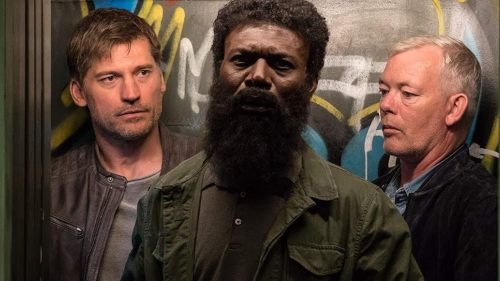Everybody’s Into Weirdness: RAISING CAIN (1992)
The Alamo Drafthouse is a brand built on weird. Beyond being situated in a town that has long aspired to remain eccentric in the face of all normality, it’s easy to forget that the original Alamo started as something of a private screening club, running prints of the odd and obscure into all hours of the night. Though the company has obviously grown into an internationally recognized chain of first run movie palaces, the Drafthouse Ritz in Austin, Texas remains committed to showcasing genre repertory programming, namely via its Terror Tuesday and Weird Wednesday showcases. This column is a concentrated effort to keep that spirit of strangeness alive, as programmers Joe A. Ziemba and Laird Jimenez (often pulling from the extensive AGFA archives) are truly doing Satan’s bidding by bringing ATX weekly doses of delightful trash art.
Author’s Note: Welcome Back! I know it’s been too long since the last installment of Everybody’s Into Weirdness, so let me take a brief moment to apologize to the twelve of you who regularly read this column. A combo of “life getting in the way” and general burnout kept me from writing on strange cinema for the last few months. However, the time off was good, because I’m back and ready to rip into the odd and unusual yet again. The column’s returning, regular-like; now on a bi-weekly basis.
The thirty-eighth entry into this disreputable canon is Brian De Palma’s bonkers multiple personality child kidnapping case, Raising Cain…

Year: 1992
“Hickory, dickory dock, Cain has picked his lock. The cat’s in the bag and the bag is in the river. So don’t fuck with me, dad. You may lose more than your license this time.”
The story goes: Brian De Palma came of age in a Philadelphia operating room. He saw a lot of blood, and became both desensitized to and fascinated by the way human bodies open up. His father, Anthony De Palma, was a renowned orthopedic surgeon who authored several texts on the subject, such as “Diseases of the Hip in Children” and “Genetics of Congenital Deformity”. Even by the auteur’s own admission in the recent De Palma documentary, Anthony was a cold and distant man, often absent from his family for long periods of time, leaving Brian’s mother, Vivienne, to care for him and his siblings. As he grew older, De Palma suspected that his father was cheating on his mother and, in rather brazen fashion, followed Anthony, catching him and one of his mistresses in the act. Pictures from this discovery have often been referred to as the director’s “first film”, as he captured a hidden truth following a lengthy period of observation. Long before he began his celluloid conversation with Hitchcock, De Palma was a voyeur – always watching and recording his findings.
Dressed to Kill was the first Brian De Palma picture to unashamedly integrate these sordid autobiographical details into his trademark pulp tales. De Palma’s narratives featured genius specialists twice before (with Dr. Emil Breton in Sisters [‘73] and Dr. Byrd in Home Movies [‘80]), and former Bob Fosse stand-in, Keith Gordon, would now ostensibly play the director for the second time, but it was De Palma’s zeroing-in on the consequences of spousal neglect that set DTK apart from his previous fictional forays. Kate Miller (Angie Dickinson) becomes increasingly bored with her seemingly perfect New York life, slipping further and further into dangerous fantasy thanks to the way her husband (Norman Evans) takes her for granted. Tired of early morning “wham bam specials”, she attempts to not only seduce her psychiatrist (Michael Caine – playing a variation on the “brilliant doctor” in Robert Elliott), but ends up engaging in a tryst with a complete stranger (Ken Baker) after a dizzying afternoon at the city’s Metropolitan Museum.
Ultimately falling victim to the straight razor of transsexual maniac Bobbi –Dr. Elliott’s most unstable patient –Kate’s final fate (not to mention the venereal disease she contracts thanks to the afternoon delight) comes off as De Palma damning the woman for her infidelity, but that reading completely disregards the warmth and empathy his movie shows toward the unloved housewife. Cheaters never prosper (and definitely die) in Brian De Palma’s world, but this ugly inevitability will be avenged by his avatar, as the science kid steps away from his invented mathematical machine (a variation on the Analog Differential Equation Computer that won De Palma top prize at his high school regional science fair in real life) and start sleuthing in a fashion not too unlike the way De Palma caught his own father stepping out on his family. Thankfully, the nerd bomber has some assistance in the form of a high class hooker (played by De Palma’s former spouse and Carrie star, Nancy Allen) who also happens to be the only witness to Kate’s gruesome demise. It’s the act that’s punished, while the purity of motherhood needs to be defended – no doubt a reductive play on Madonna/Whore Complex that finds the director working out his deep seated personal issues with women on screen.
Brian De Palma loves to make movies that act as funhouse mirror reflections of one another. Carlito’s Way could be interpreted as he and Al Pacino’s tear soaked apology letter, pleading for redemption after the wanton, bloated excess of Scarface. Redacted is a found footage update of Casualties of War, reminding us that combat can often act as a warm blanket for society’s greatest monsters. Obsession and Body Double find De Palma returning to the well of Vertigo, the motion picture that helped his brain fuse its understanding of functional mechanics with a need to tell tales of possessive madness. Nevertheless, none of the pairings quite complement each other like Raising Cain and Dressed to Kill. Building on his tendency toward first-person trash art with reckless abandon, Cain is a dream state rehash of Hithcock’s Psycho, tossed into a cinematic blender with Michael Powell’s Peeping Tom. An in-joke seemingly told only for the hardcore heads and his own amusement, De Palma’s nineteenth feature is a formal marvel that is in dialogue with the thriller dialect its author had perfected over the past twenty years.
The responsibility of fatherhood hangs over every frame of Raising Cain, so much so that the "Written and Directed By" credit is superimposed over an image of our anti-hero, Dr. Carter Nix (John Lithgow), comforting his daughter in her bed. It's no coincidence that De Palma had just fathered his first child with his second wife (and Cain Producer) Gale Anne Hurd, but the filmmaker credits a friend as being the primary inspiration for the picture's multi-personality, kidnap prone, child psychologist. De Palma became fascinated by this unnamed associate's professional sabbatical, during which they stayed home with their own offspring in order to monitor the emotional effects it would have on the child. Omnipresence takes the place of his own father's absenteeism, yet the end results are just as traumatizing, as Nix's wife, Jenny (Lolita Davidovich), experiences quite literal coitus interruptus thanks to her brilliant and dangerous husband's rearing pre-occupation.
Jenny is a stone's throw away from being a carbon copy of Kate Miller, only instead of running into the arms of a shade-sporting stranger, she finds comfort in bland former beau, Jack (Scarface’s Stephen Bauer). De Palma handles their resulting rendezvous with the same arm's length empathy he displayed for Ms. Miller's, but the cinematic tools employed to portray their rekindled flame couldn't be more different. Where Dressed to Kill found De Palma indulging in one of his characteristic set pieces (arguably the greatest of his storied career), Raising Cain becomes a cascade of non-linear remembrances and sudden love letter voice over. The filmmaker is fracturing the formal tricks he's so enamored with, toying with editing and rhythm while cannibalizing his self-established character archetypes. Jenny senses what she's doing is wrong, but her "perfect man" cannot pull away from his “work” for even a mere instance of horniness, resulting in a bout with boredom that spirals into madness and mayhem once Carter witnesses she and Jack's lovemaking.
John Lithgow has often been De Palma's go to for sociopaths, and in Cain he gets to riff on the director's favorite Psycho. The shadow of Anthony Perkins' Norman Bates previously loomed large over one cross-dressing antagonist (Dressed to Kill’s deeply, deeply #problematic Bobbi), and is now utilized as a template to showcase Lithgow's hammier leanings. The amount of fun Lithgow is having playing Dr. Nix's numerous personalities cannot be understated, as he transitions from loving father to scared little boy to mad scientist to protective older sister during the course of the movie's manic 91-minute runtime. It's a mugging, mischievous bit of theater, often spilling over into high camp but never once faltering in terms of character. Lithgow is able to convey pages worth of internalized backstory via posture and cadence alone, eating up De Palma's melodramatic dialogue and then spitting it out at the audience as he holds menacing command over every scene. Many have described the writer/director’s output as being "pure cinema", and here he has an actor that meets his baroque filmic style in a manner that can only be categorized as "pure performance". It's a marvel to behold.
De Palma's usual visual audacity becomes something of an in-joke during Raising Cain, as he calls attention to his split diopter shots and operatic slow motion with the subtlety of a neon sign. This ostentatiousness is best represented by a seemingly endless long-take follow, where two hard-nosed cops have exposition dumped on their heads by one of Nix's colleagues, all while De Palma's camera (manned by consummate cinematography collaborator, Stephen H. Burum) leads its subjects like a coked out lure on a greyhound race track. Body Double’s Gregg Henry (playing one of the dicks on Nix's trail) almost seems to be blocking in the moment, as he physically catches his co-star in the scene (Frances Sternhagen) before she walks out of frame. It's a thrillingly hilarious moment of technical wizardry, as De Palma is recognizing the thumbprint he minted over numerous thrillers and is now turning it into a playful gag for the devoted sitting in a darkened theater.
Though De Palma references Psycho, both in terms of his antagonist and via a complete visual lift (Carter sinking Jenny’s car in a bog will seem eerily familiar to fans of Hitchcock’s classic), another substantial inspiration on Raising Cain was Michael Powell’s Peeping Tom. In Powell’s ‘60 horror masterpiece, a psychiatrist subjects his young son to a series of traumatizing experiments, just so he can capture the boy’s reaction on film. The son then channels the sins of his father through his own “art”, killing off prostitutes while filming their reactions as he stabs them with a spike that’s built onto his camera’s tripod. Like Powell’s titular freakshow, we learn that Carter’s psychosis is the result of trauma inflicted by his dad, a renowned child psychologist who wanted to observe the effects his trials had on his son. De Palma is again channeling experience through influence and maybe even playing out his fears as a new father onscreen. Will he become a workaholic non-entity like his own dad? Or will he be able to balance his artistic and home lives in order to become a positive influence on his child’s development? It’s worth nothing that Cain was shot minutes away from De Palma’s Northern California residence, so that neither he nor Hurd would ever be too far away from their own darling daughter.
Raising Cain is not De Palma’s best picture, but it is one of his most fascinating. By returning to his Hitchcockian well, along with the cinematic grammar he’d developed to express himself, the movie becomes almost abstract in its self-referential friskiness. We’re learning about the man himself while he continues to keep the curtain drawn; entertainment presented as sleight of hand in order for us to not fully realize how cathartic this narrative may actually be for him. It’s no wonder De Palma would take ten years off from making anything remotely resembling an “erotic thriller” (Femme Fatale and Passion would come out in separate decades), filling those years with big budgeted studio work (Mission: Impossible, Mission to Mars) as well as a gangster reunion (Carlito’s Way) and a paranoid political assassination plot (Snake Eyes). He’d said just about all he needed to say in the genre, and refused to resurrect the autobiographical details in even those two later works. In short, De Palma was done with his dad, and it was time to once again try something new after artistically ridding himself of his own psychic trauma.
Next Week at Weird Wednesday: Looker
Previous WW Features: Penitentiary; Skatetown USA; Blood Games; The Last Match; Invasion of the Bee Girls; Julie Darling; Shanty Tramp; Coffy; Lady Terminator; Day of the Dead; The Kentucky Fried Movie; Gone With the Pope; Fright Night; Aliens; Future-Kill; Ladies and Gentlemen…The Fabulous Stains; Pieces; Last House on the Left; Pink Flamingos; In the Mouth of Madness; Evilspeak; Deadly Friend; Don’t Look in the Basement; Vampyres; She; Dolls; Alice, Sweet Alice; Starship Troopers; Message From Space; Rabid; Child’s Play; Lost in the Desert; Suspiria; Effects; Friday the 13th Part VIII: Jason Takes Manhattan; Thomasine & Bushrod; Hard Ticket to Hawaii



